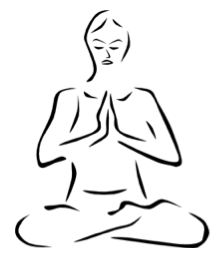by atmara | Apr 25, 2011 | Art, Mandala Monday, Mandalas, Meditation, Spiritual Awakening

Healing Mandala 4 © Atmara Rebecca Cloe
Today’s post is courtesy of Article Legacy (Note: this article was clearly translated into English. I have taken the liberty of correcting grammar and awkward sentence structure.)
The idea that painting and graphics have the ability to influence the spiritual state of a person has been known from the ancient times and is also proved by the latest scientific researches. In India special graphic images for entrance to the state of trance have gotten the name “jantra” or mandala. Meditation with mandalas allows one to carry these images to your consciousness in the visual form, to consolidate them and also to come to higher levels of the spontaneous, “direct” perception of the objects of meditation and the whole world in general. Besides, in mandalas within the graphic forms many esoteric aspects of secret teaching have been coded, these teachings show that with every new experience a mandala can show new sides of its inner sense to a student and aid in spiritual awakening.
The methodology of mediation.
1. Sit down in a meditative pose and relax. Calm your breathing, taking it into your control.
2. Concentrate on the image of the mandala. The mandala has to be placed on the level of your eyes at distance of 2-8 inches (depending on the size of the drawing).
3. Imagine that while taking deep breathes, you bring into yourself the innermost essences of the mandala, and breathing out you get rid of all negative thoughts. In 30 seconds to one minute of this “figurative” breathing you will stop paying attention to breathing, as if it does not exist at all or is some insignificant attribute of your body form.
4. Keep opening to the inner sense of the mandala.
5. Try to open to the meaning and properties of very part of the mandala by isolating it separate elements.
6. Come back to the complex generalized perception. The mandala is not just a disorderly set of some symbols. There is its own special sense in this combination and connection of the parts of the mandala. Try to perceive this sense.
7. If you feel yourself tired, stop the exercise, be satisfied with what you have found out about the mandala (“from the mandala”) at the given moment. Take your attention to your breath, repeat “AUM” three times and stand up slowly.
What does this exercise give to you? First of all it is really a great relaxation. You spend about fifteen twenty minutes doing this exercise but after it you will feel as if you had been having rest for several hours. Your abilities in figurative thinking become much better also.
Texts of mantras you will easily find on the Internet, as for a mandala itself you also can find the drawings in Internet, but it would be much better if you draw a mandala yourself. It is very easy and your own mandala will work much better for you.
The current world is the world of rush and urgent matters. We hardly can find a minute to stop and think about the Universe and our inner selves. In this case mandalas could help you divert away from routine and contemplate for a while.
Please make sure to get back to this web site, Article Legacy on a regular basis to find information on a variety of topics.
—————————————————————————————————————
There are a variety of mandalas online and for purchase in my Zazzle Store which could be used for meditation. If you have not already visited my Video page, please do as you will find a number of moving mandala images for use in meditation. You can also download these videos to your computer by visiting my Freebies page.
—————————————————————————————————————
I look forward to your thoughts and comments!
Be sure to Subscribe to this blog either by RSS or Email via the forms on the top right column of the page.
Like this:
Like Loading...
by atmara | Apr 11, 2011 | Art, Creativity, Mandala Monday, Mandalas, Meditation, Video
I’ve created a new mandala meditation video for you from photos of spring flowers. Enjoy!
Video © Atmara Rebecca Cloe Music © Christopher Lloyd Clarke,(www.The-Guided-Meditation-Site.com)
—————————————————————————————————————
I look forward to your thoughts and comments! Be sure to Subscribe to this blog either by RSS or Email via the forms on the top right column of the page.
Like this:
Like Loading...
by atmara | Feb 7, 2011 | Healing, Meditation, Thriving
 The West’s traditional method of treating depression involves psychotherapy and medication, but with the rising popularity of yoga across the world, it’s become more difficult to ignore yoga practitioners’ claims of uplifted moods and eased ailments. Scientific research on the benefits of yoga for those suffering from depression remains sparse and generally comes attached with a cautionary warning that the findings may be unreliable.
The West’s traditional method of treating depression involves psychotherapy and medication, but with the rising popularity of yoga across the world, it’s become more difficult to ignore yoga practitioners’ claims of uplifted moods and eased ailments. Scientific research on the benefits of yoga for those suffering from depression remains sparse and generally comes attached with a cautionary warning that the findings may be unreliable.
Yoga and the Scientific Community
Have a heart-to-heart with any devoted yogi—not just someone who’s in it for the cute pants or the weight loss—and you will hear a train of praises for the physical and psycho-emotional benefits of the art. In fact, in 2004, the University of California, LA, conducted an experiment that involved 28 mildly depressed young adults on campus who participated in two hour-long sessions of Iyengar yoga weekly for 5 consecutive weeks. “Subjects who participated,” reports the abstract, “demonstrated significant decreases in self-reported symptoms of depression and trait anxiety. . . . Changes were also observed in acute mood, with subjects reporting decreased levels of negative mood and fatigue following yoga classes.” (See the abstract of the study here: http://www.ncbi.nlm.nih.gov/pubmed/15055096?dopt=Citation.) The study was typical in its findings as well as its call for greater level of scrutiny, which remains underway today.
Yoga and Your Body
On a (mostly) physical level, regular practice of yoga can alleviate depression by reducing the physiological manifestations of stress. This means easing cramped shoulders, stretching tight hips, and triggering the release of endorphins—the happy hormone. Even slower and less physically strenuous versions of yoga (such as Iyengar and Anusara) can help the body release toxins by providing deep muscle and organ movements as well as strength and flexibility. Individuals suffering from low self-esteem or feelings of weakness (such as after the loss of a loved one) can benefit from feeling powerful through yoga, which tones muscles and encourages deep breathing. Sun salutations, shoulder stand, and the warrior poses are particularly powerful, ego-boosting poses that involve upward motions and stretching or wide stances and feelings of grounding.
Yoga and Your Mind
Yoga has psychological, emotional, and—for some—spiritual effects, too. Yoga often entails meditation, which encourages shedding of stress and earthly concerns in favor of intense awareness of things beyond the self, often provoking a feeling of universality and nothingness at once. Practitioners of course experience varying sensations and bring different philosophies to yoga and meditation, but mindfulness, being in the present, and loving kindness to oneself as well as others are key points in both practices.
Yoga as a Tool to Heal from Depression
This is not to say that severe depression or chemical conditions such as bipolarity can be utterly solved through yoga—many cases still require professional aid. Mayo Clinic and other institutions now admit, however, that yoga may be a complementary method of treating depression.
Yoga holds a few advantages over traditional methods of treating anxiety and depression.
- Personal practice is free, and even lessons and books cost less compared to medication or therapy
- No need to depend on someone else’s schedule; a yoga practitioner may heal whenever he or she wishes.
- Healing without medication and through the power of the self may provide increased self-esteem.
Make sure to join a class or study yoga and its safe execution before attempting its regular practice. (Improper training can result in physical injuries, however slow the style of yoga.) If you suspect you suffer from severe depression, do not attempt to self-treat. Remember that yoga is not a cure-all but simply a helpful, soothing, and invigorating tool to get you back on your feet.
Bio: Maria Rainier is a freelance writer and blog junkie. She is currently a resident blogger at First in Education where recently she’s been researching the highest paying associate degrees versus the lowest paying associate degrees. In her spare time, she enjoys square-foot gardening, swimming, and avoiding her laptop.
———————————————————————————————————
I look forward to your thoughts and comments!
Be sure to Subscribe to this blog either by RSS or Email via the forms on the top right column of the page.
Like this:
Like Loading...


